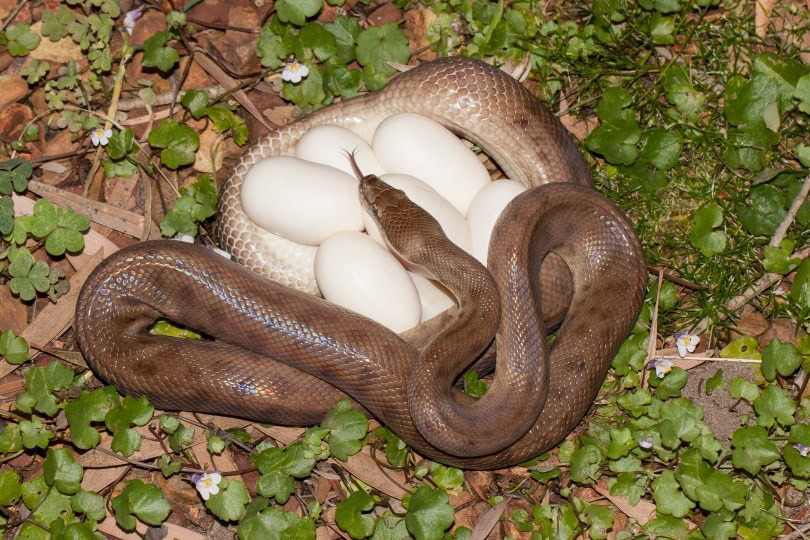Click to Skip Ahead
Knowing how to identify snake eggs offers numerous benefits. If you’re a snake lover, knowing what snake eggs look like will curb your curiosity and add to your knowledge base. If you’re not fond of snakes but live somewhere that’s home to venomous snakes, it’s important to know what the eggs look like so you can avoid the area. If you own property, knowing what snake eggs look like can help keep unwanted intruders at bay. All in all, being able to identify snake eggs is beneficial, so keep reading to learn how to do just that.

Snake Eggs Don’t Look Like Chicken Eggs
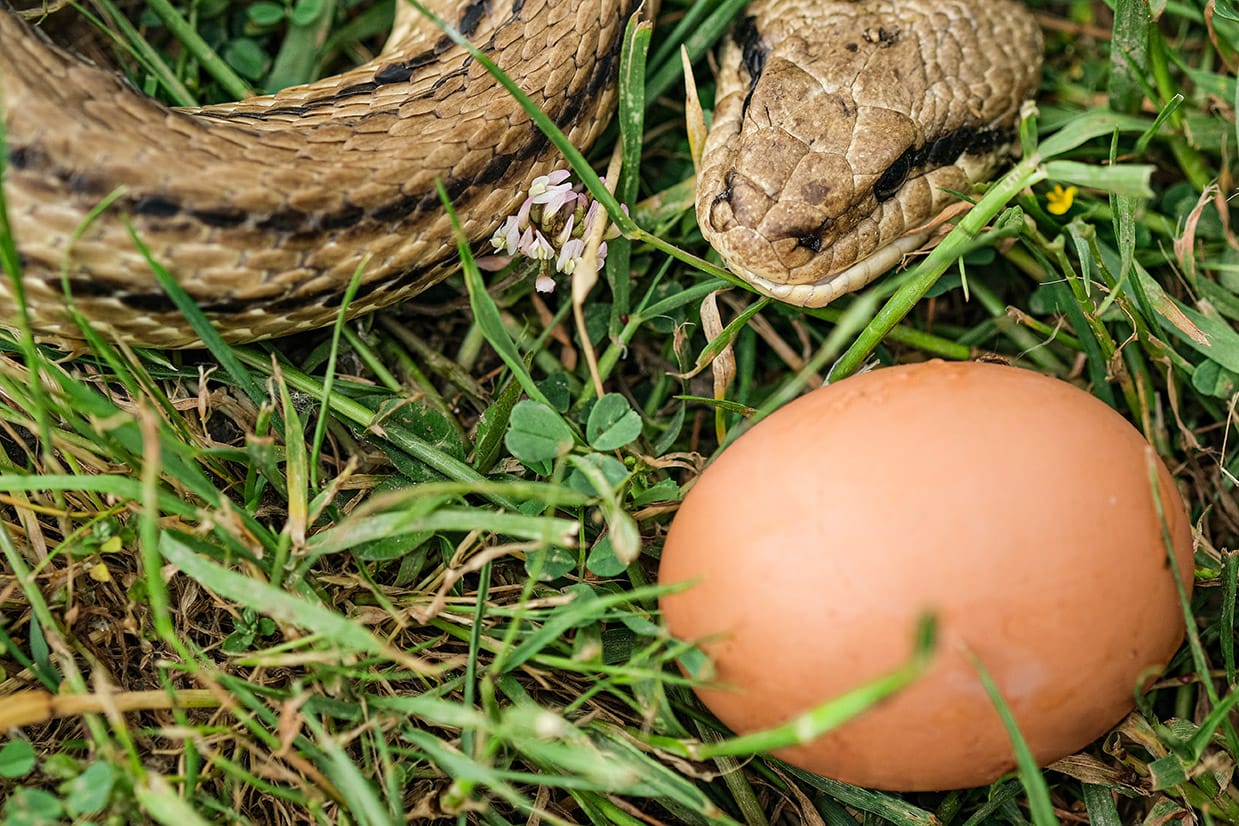
Some people might think snake eggs resemble chicken eggs. The truth is, however, that snake eggs don’t resemble chicken eggs at all. Chickens and other birds lay roundish-shaped eggs with hard shells. The hard protective shell of a bird egg accommodates the weight of the mother bird when she sits on them to keep them warm.
Snake eggs are oblong-shaped and have rubbery shells that are pliable. The size of the eggs will also vary based on the snake species.
Where You’ll Find Snake Eggs
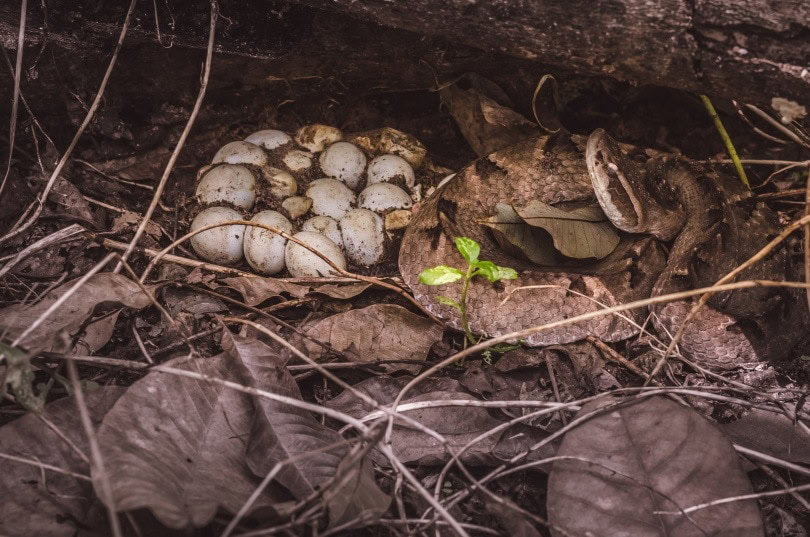
Many species of snakes lay eggs in damp, warm, and dark places, so many bury their eggs in dirt, compost, or loose and moist ground. Some snakes lay their eggs inside dying trees, under bushes, in compost or manure, and in other warm and moist places.
By laying their eggs in these types of places, Mother Nature serves as an incubator. Most female snakes lay their eggs and then abandon them completely, except for cobras or pythons.
If you’re wondering how many eggs a mother snake lays, that number can vary considerably. Some species may only lay a couple of eggs, while others lay one hundred at a time.
What to Do if You Find Snake Eggs
If you stumble across snake eggs in the wild, it’s best to leave them be. If the eggs are from a species you don’t want around, contact a local wildlife center or a snake expert to help you remove the eggs.
It can be risky to remove snake eggs because you never know if adult snakes are nearby. The last thing you want to happen is to be bitten by a venomous snake. Be on your guard whenever you stumble upon what you believe to be snake eggs.
Snake Eggs Aren’t Easy to Identify by Species
The tricky thing about snake eggs is that they’re notoriously difficult to identify according to species. Knowing the species of a snake egg is possible by the shape, hardness, and appearance, but it’s far easier if you’re an educated snake professional.
The texture and hardness of the shell are one of the easiest ways to differentiate between a snake egg and a bird egg. As mentioned above, birds lay hard-shelled eggs, while snake eggs are softer and much more supple.
As far as color goes, most snakes in North America lay eggs that are white, off-white, or beige. Snake eggs are not usually as large as chicken eggs, but they can range in size according to species.
A surprising fact about snake eggs is that they can slightly increase in size as they’re being incubated. The egg encasing the growing embryo absorbs water, resulting in the egg getting larger until the hatchling inside emerges through the shell.
Generally speaking, snake eggs tend to be just over 1 inch long, while other reptiles, like lizards, lay smaller eggs. It’s a safe bet to assume you have snake eggs if the eggs are light-colored, rubbery, and around 1 inch in length.

Snakes Reproduce in Different Ways
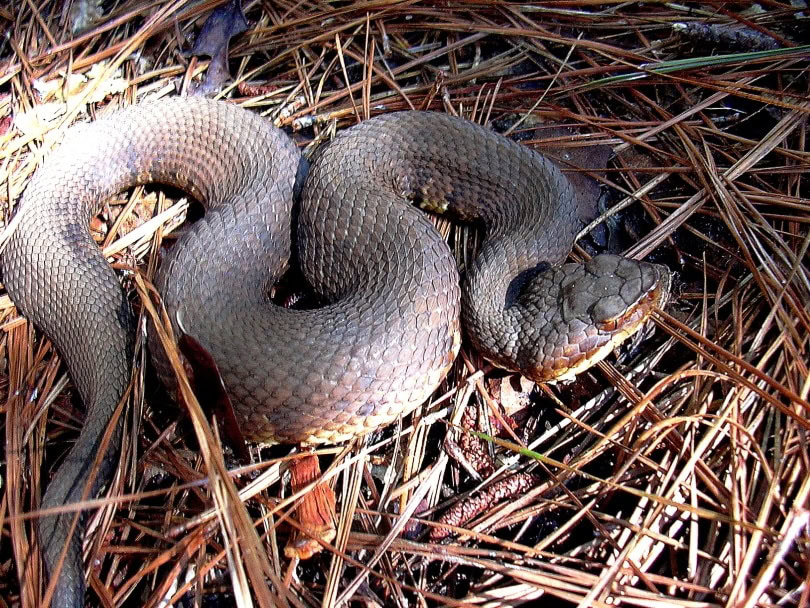
It’s important to know that not all snakes lay eggs. Some species give live birth to their young. You may be surprised to learn that there are three distinct methods of snake reproduction, which we’ll cover below.
- Oviparous Reproduction
The majority of snakes are oviparous, which means they lay eggs. Once the eggs are laid, they’re kept warm or incubated until the hatchlings emerge from the shell.
- Viviparous Reproduction
Viviparous snakes don’t lay eggs. Instead, they nourish their developing babies through a placenta and yolk sac and give birth to live young with no eggs involved at all.
- Ovoviviparous Reproduction
An ovoviviparous snake is like a combination of an egg layer and one that gives birth to live young. This type of female snake develops eggs inside her body. When the young are born, they emerge from the eggs inside the mother’s body and enter the world fully active with no eggshells in sight.

Identifying Snake Eggs
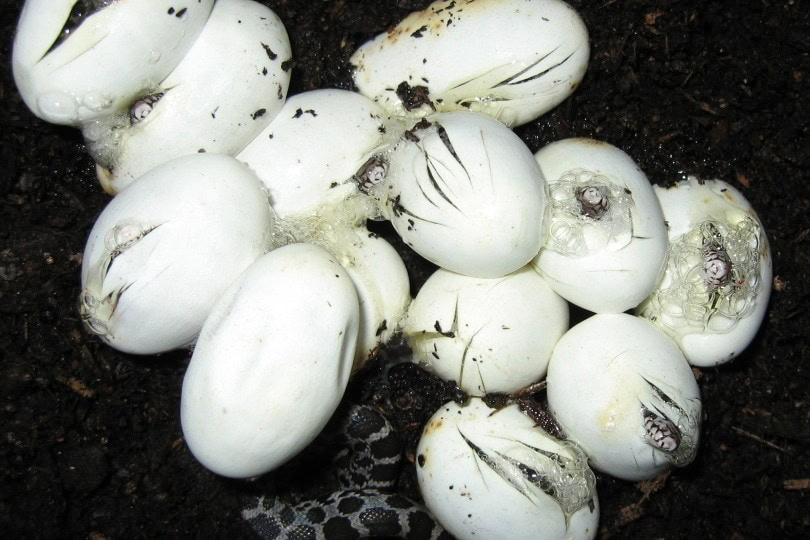
There are over 50 species of snakes living in the United States, which means there are lots of snake eggs in the wild. Of those 50 species, approximately 20 are venomous snakes which means they produce venom and deliver it via injection using their fangs.
Anywhere from 7,000 to 8,000 people in the United States are bitten by venomous snakes every year. You can get very sick from a venomous snakebite and even die if you don’t receive anti-venom quickly. That’s why it’s a good idea to keep an eye out for venomous snakes so you can stay away from these potentially deadly reptiles.
Venomous Snake Eggs Are Uncommon in the US
Unless you live in the southeastern or southwestern portion of the United States, you’ll likely never run across snakes’ eggs coming from a venomous species. Why is this? Because only one egg-laying venomous snake lives in the United States, and it’s a beautiful and elusive creature called the coral snake.
There are two types of coral snakes: old-world coral snakes found in Asia and new-world coral snakes found in the Americas. In the United States, there are eastern coral snakes and western coral snakes.
Eastern coral snakes live in the southeastern part of the country in an area ranging from the Carolinas to Florida and Texas. This snake’s body is entirely covered in bright bands of black, red, and yellow.
Western coral snakes live in the southwestern part of the country and have the same basic color pattern as their eastern counterparts; only the colors are more muted. In particular, the yellow bands are paler and can be white.
Coral Snake Eggs

Eastern coral snakes lay six or seven eggs, while western coral snakes lay two to three eggs. Both snakes lay their eggs during the summer months, and they hatch in the fall. So, what do these eggs look like?
Coral snake eggs are white, oblong, soft, pliable, and about 1 inch long. If you live in an area known for having coral snakes and you come across eggs fitting this description, they are likely coral snake eggs.

Final Thoughts
If you are dead set on learning how to identify specific species of snake eggs, you should educate yourself. You can sign up for a college course, join a workshop run by a wildlife organization, or work closely with a snake expert.
Snakes are fascinating creatures that vary considerably in size and color. But their eggs aren’t colorful, nor are they easy to identify, as most snake eggs look very much alike.
Remember to leave snake eggs be if you run across them in the wild. Snakes are an important part of our ecosystem. Snakes help control the pest population by eating mice and other small rodents that damage crops and carry disease.
- https://zooatlanta.org/cold-blooded-whats-it-mean/
- https://www.britannica.com/animal/snake/Egg-formation-and-laying
- https://sciencing.com/identify-snake-eggs-4866367.html
- https://pubmed.ncbi.nlm.nih.gov/22777731/#:~:text=The%20vast%20majority%20of%20squamate,%2C%20volume%2C%20and%20surface%20area.
- https://www.cdc.gov/niosh/outdoor-workers/about/venomous-snakes.html
- https://gadnr.org/sites/default/files/wrd/pdf/fact-sheets/Venomous%20Snakes%20-%20Eastern%20Coral%20Snake.pdf
- https://www.livescience.com/43938-coral-snakes-colors-bites-farts-facts.html#:~:text=According%20to%20the%20ADW%2C%20they,inches%20(17%20cm)%20long.
Featured Image Credit: Ken Griffiths, Shutterstock
